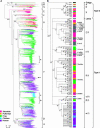Evolutionary dynamics of olfactory receptor genes in fishes and tetrapods
- PMID: 15824306
- PMCID: PMC1087945
- DOI: 10.1073/pnas.0501922102
Evolutionary dynamics of olfactory receptor genes in fishes and tetrapods
Abstract
Olfaction, which is an important physiological function for the survival of mammals, is controlled by a large multigene family of olfactory receptor (OR) genes. Fishes also have this gene family, but the number of genes is known to be substantially smaller than in mammals. To understand the evolutionary dynamics of OR genes, we conducted a phylogenetic analysis of all functional genes identified from the genome sequences of zebrafish, pufferfish, frogs, chickens, humans, and mice. The results suggested that the most recent common ancestor between fishes and tetrapods had at least nine ancestral OR genes, and all OR genes identified were classified into nine groups, each of which originated from one ancestral gene. Eight of the nine group genes are still observed in current fish species, whereas only two group genes were found from mammalian genomes, showing that the OR gene family in fishes is much more diverse than in mammals. In mammals, however, one group of genes, gamma, expanded enormously, containing approximately 90% of the entire gene family. Interestingly, the gene groups observed in mammals or birds are nearly absent in fishes. The OR gene repertoire in frogs is as diverse as that in fishes, but the expansion of group gamma genes also occurred, indicating that the frog OR gene family has both mammal- and fish-like characters. All of these observations can be explained by the environmental change that organisms have experienced from the time of the common ancestor of all vertebrates to the present.
Figures


Similar articles
-
Evolution of trace amine associated receptor (TAAR) gene family in vertebrates: lineage-specific expansions and degradations of a second class of vertebrate chemosensory receptors expressed in the olfactory epithelium.Mol Biol Evol. 2007 Sep;24(9):2099-107. doi: 10.1093/molbev/msm140. Epub 2007 Jul 18. Mol Biol Evol. 2007. PMID: 17634392
-
Phylogeny and evolution of class-I helical cytokines.J Endocrinol. 2006 Apr;189(1):1-25. doi: 10.1677/joe.1.06591. J Endocrinol. 2006. PMID: 16614377 Review.
-
A novel olfactory receptor gene family in teleost fish.Genome Res. 2007 Oct;17(10):1448-57. doi: 10.1101/gr.6553207. Epub 2007 Aug 23. Genome Res. 2007. PMID: 17717047 Free PMC article.
-
Differential evolution of voltage-gated sodium channels in tetrapods and teleost fishes.Mol Biol Evol. 2011 Jan;28(1):859-71. doi: 10.1093/molbev/msq257. Epub 2010 Oct 5. Mol Biol Evol. 2011. PMID: 20924084
-
From 2R to 3R: evidence for a fish-specific genome duplication (FSGD).Bioessays. 2005 Sep;27(9):937-45. doi: 10.1002/bies.20293. Bioessays. 2005. PMID: 16108068 Review.
Cited by
-
Modeling the Orthosteric Binding Site of the G Protein-Coupled Odorant Receptor OR5K1.J Chem Inf Model. 2023 Apr 10;63(7):2014-2029. doi: 10.1021/acs.jcim.2c00752. Epub 2023 Jan 25. J Chem Inf Model. 2023. PMID: 36696962 Free PMC article.
-
Comparative genomic analysis identifies an evolutionary shift of vomeronasal receptor gene repertoires in the vertebrate transition from water to land.Genome Res. 2007 Feb;17(2):166-74. doi: 10.1101/gr.6040007. Epub 2007 Jan 8. Genome Res. 2007. PMID: 17210926 Free PMC article.
-
Reassessing domain architecture evolution of metazoan proteins: major impact of errors caused by confusing paralogs and epaktologs.Genes (Basel). 2011 Aug 2;2(3):516-61. doi: 10.3390/genes2030516. Genes (Basel). 2011. PMID: 24710209 Free PMC article.
-
Co-opting the unfolded protein response to elicit olfactory receptor feedback.Cell. 2013 Oct 10;155(2):321-32. doi: 10.1016/j.cell.2013.09.033. Cell. 2013. PMID: 24120133 Free PMC article.
-
Origin of the genetic components of the vomeronasal system in the common ancestor of all extant vertebrates.Mol Biol Evol. 2009 Feb;26(2):407-19. doi: 10.1093/molbev/msn262. Epub 2008 Nov 13. Mol Biol Evol. 2009. PMID: 19008528 Free PMC article.
References
Publication types
MeSH terms
Grants and funding
LinkOut - more resources
Full Text Sources
Molecular Biology Databases

